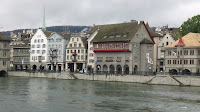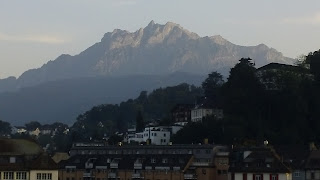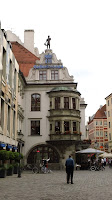
We
arrive in Florence, and into what is truly the Italian leg of the
trip. Venice is a city filled with such an "otherness" that
it is probably not indicative of what the rest of Italy felt like
(however, we would find that each region of Italy can differ vastly
from the others). Considered to be the heart of
the Renaissance movement, and with the prominent shadow of
the Medici family still felt, Florence seems driven by three forces:
art, money, and politics. The true beauty of the area, I feel, lies
in its surrounding countryside, with its vineyards, stone pines, and
cypresses. Once you leave this, you enter into a rather pedestrian
outer layer of the city, with many modern complexes and architecture,
which is where we stayed. From here, it is about a 15 minute walk
into the densely packed historical section of the city, where most of
the interest lies, and where most of the tourists gather. At this
point, we had been traveling for weeks, but nothing we had seen in
prior cities prepared us for the overwhelming gobs of sightseers in
Florence. Unlike, say, Rome, Florentine visitors tend to wander free
of tour groups, surrounding us in an odd and, to be honest, mostly
obnoxious, English cocoon. While I know that I've complained about
Americans acting holier than thou about tourism (I've never claimed
to not be a hypocrite), I think everyone in our group became
increasingly annoyed at having to constantly overhear pretentious
and/or clueless people groping their way through the city. My eyes
rolled so much, I worried someone would think I was having some sort
of seizure.
 So,
let's talk a little about that "art, politics, and money."
Florence, thanks in large part to the aforementioned Medicis'
patronage/greed, has an astounding amount of incredible art, most of
it housed in some of the world's most amazing museums. Yes, it really
does garner that many superlatives. For me, the art and the history
oftentimes outshone the architecture, and, indeed, the city itself.
Florence in July is hot, and hot in a uniquely inescapable way. You
simply get used to sweating all the time (or, as I once said, "I'm
glistening like the top of the Chrysler Building!"), and
only lying perfectly still in the shade offered any sort of relief.
Along with the heat came the smells, and Florence has the
tremendously dubious distinction of being the stinkiest city that we
visited. Essentially, about once every few minutes, you got a big
whiff of sewage. Once when I was buying gelato, one of these odors
wafted by, and I wrinkled my nose. The gelatiere looked alarmed and
said, "It's not me, it's...," and pointed down to the sewer
grate. Also, being about the height of most people's armpits, I got
that odoriferous delight as well. The heat and the smells were
compounded by the fact that the main areas of Florence are very
dense. Like Venice, it has the small streets (though
nothing compared to Venice, where you can get a 'the walls are
closing in' feeling), interspersed with courtyards. In most of the
historical section, cars are not allowed, excepting taxis and tiny
service vehicles. Florence is a bike city, and we're not talking
bicycle. And we're not talking 'hogs'. Vespas and Suzukis are
everywhere, and everyone, from little old ladies to businessmen in
3-piece suits, zip around in them. Walking down the streets,
sometimes it looked like a Japanese motorbike dealer had just parked
his entire inventory on the street.
So,
let's talk a little about that "art, politics, and money."
Florence, thanks in large part to the aforementioned Medicis'
patronage/greed, has an astounding amount of incredible art, most of
it housed in some of the world's most amazing museums. Yes, it really
does garner that many superlatives. For me, the art and the history
oftentimes outshone the architecture, and, indeed, the city itself.
Florence in July is hot, and hot in a uniquely inescapable way. You
simply get used to sweating all the time (or, as I once said, "I'm
glistening like the top of the Chrysler Building!"), and
only lying perfectly still in the shade offered any sort of relief.
Along with the heat came the smells, and Florence has the
tremendously dubious distinction of being the stinkiest city that we
visited. Essentially, about once every few minutes, you got a big
whiff of sewage. Once when I was buying gelato, one of these odors
wafted by, and I wrinkled my nose. The gelatiere looked alarmed and
said, "It's not me, it's...," and pointed down to the sewer
grate. Also, being about the height of most people's armpits, I got
that odoriferous delight as well. The heat and the smells were
compounded by the fact that the main areas of Florence are very
dense. Like Venice, it has the small streets (though
nothing compared to Venice, where you can get a 'the walls are
closing in' feeling), interspersed with courtyards. In most of the
historical section, cars are not allowed, excepting taxis and tiny
service vehicles. Florence is a bike city, and we're not talking
bicycle. And we're not talking 'hogs'. Vespas and Suzukis are
everywhere, and everyone, from little old ladies to businessmen in
3-piece suits, zip around in them. Walking down the streets,
sometimes it looked like a Japanese motorbike dealer had just parked
his entire inventory on the street.
Where
were we? Ah, yes. Politics and money. Everything costs in Florence.
Everything. Accustomed to the other nine countries we visited, it was
a little disconcerting to be confronted with prices on what was free
everywhere else. Additionally, Florence is really quite skilled at
breaking things up to maximize their earnings. Many places have
"packages" where they put one interesting thing in each
package, along with a lot of fluff. So, you have to buy every package
if you want to see all of what any logical person would want to.
Pretty sneaky, sis.
Additionally,
the bureaucracy and institutional organization (or lack of
it) had me longing for other countries' which I had previously
disparaged. Museums, ticketing offices, etc. tend to keep very odd
hours. Essentially, the hours are "we are open when we feel like
it." Information on the Internet is often wrong or outdated or
conflicting with what is officially posted (which might be ignored
anyway). Often, people show up to work when they feel like it, and it
seems so ingrained that a lot of Italians seem to greet it
with a sigh and a shrug. And, while some complain, they'll also
participate in it themselves. In addition to the opening and closing
times being confusing, Italian (and especially Florentine) sights
frequently have a bewildering ticketing system. Here is a typical
example.
"I
would like to buy 2 adult tickets."
"No,
you do that at (names a totally unrelated business/museum that is
blocks away)."
"Oh,
okay..."
"But
they're closed for three hours right now."
"Oh.
Well, I guess I can purchase tickets for tomorrow morning..."
"Oh,
we're closed tomorrow morning. But, I can sell you this premium
ticket for when we open at (names a time that is not on the sign, nor
advertised anywhere in existence). With it, you get to join the
smaller line."
*Sigh*
So,
there's a common exchange. And they don't feel any sort of pressure
to improve it because the general attitude seems to be, 'We've got a
million of you people. You seem to come no matter what. We don't care
if you get a little frustrated or we lose a few of you.'
And,
admittedly, the slowness sometimes forced you to give up and slow
down for awhile. And that was something that was nice about being in
Italy, the flip side to the frustration if you will. You have to
relax. You have no other choice. Calm down, look around, discover
some art. For a small fee.























